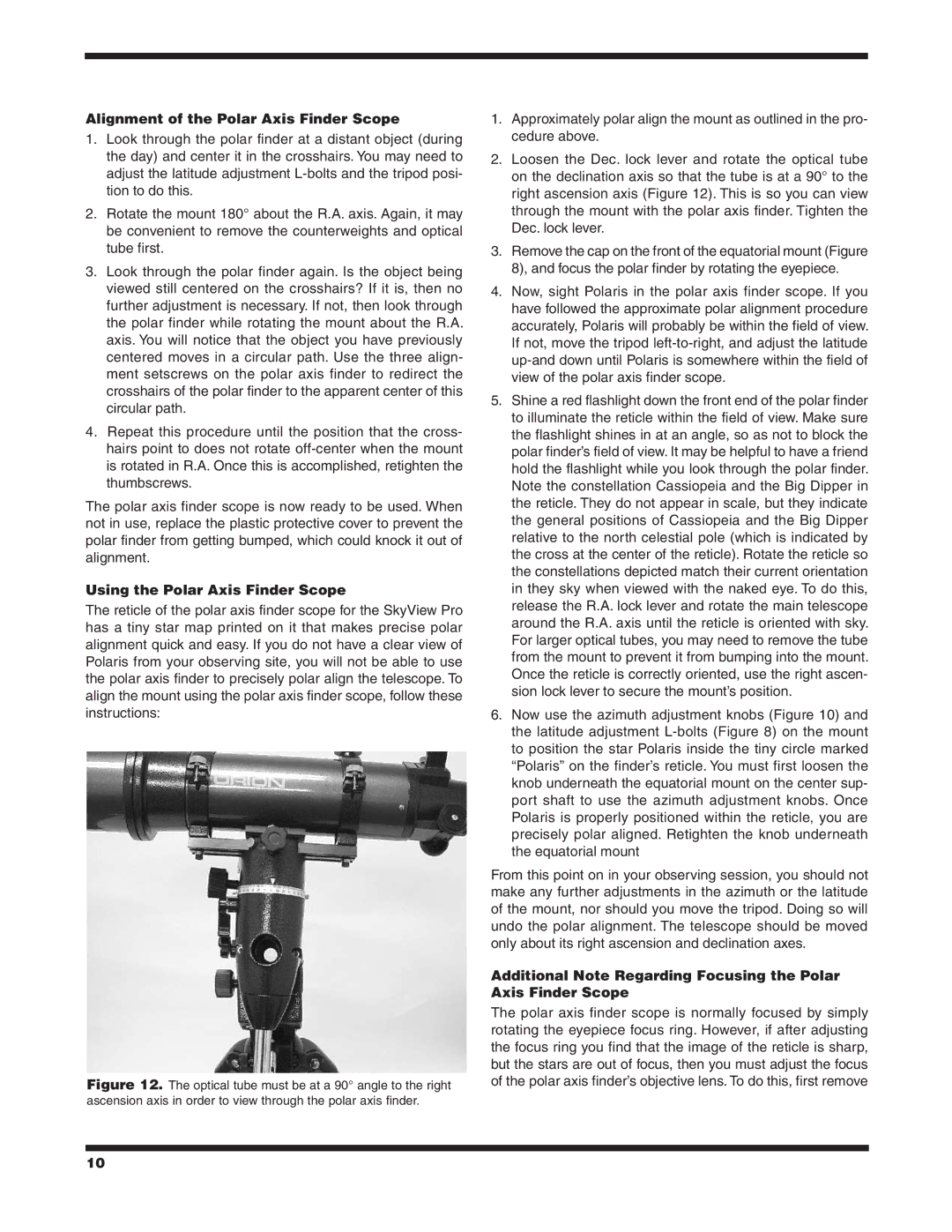
Alignment of the Polar Axis Finder Scope
1.Look through the polar finder at a distant object (during the day) and center it in the crosshairs. You may need to adjust the latitude adjustment
2.Rotate the mount 180° about the R.A. axis. Again, it may be convenient to remove the counterweights and optical tube first.
3.Look through the polar finder again. Is the object being viewed still centered on the crosshairs? If it is, then no further adjustment is necessary. If not, then look through the polar finder while rotating the mount about the R.A. axis. You will notice that the object you have previously centered moves in a circular path. Use the three align- ment setscrews on the polar axis finder to redirect the crosshairs of the polar finder to the apparent center of this circular path.
4.Repeat this procedure until the position that the cross- hairs point to does not rotate
The polar axis finder scope is now ready to be used. When not in use, replace the plastic protective cover to prevent the polar finder from getting bumped, which could knock it out of alignment.
Using the Polar Axis Finder Scope
The reticle of the polar axis finder scope for the SkyView Pro has a tiny star map printed on it that makes precise polar alignment quick and easy. If you do not have a clear view of Polaris from your observing site, you will not be able to use the polar axis finder to precisely polar align the telescope. To align the mount using the polar axis finder scope, follow these instructions:
Figure 12. The optical tube must be at a 90° angle to the right ascension axis in order to view through the polar axis finder.
1.Approximately polar align the mount as outlined in the pro- cedure above.
2.Loosen the Dec. lock lever and rotate the optical tube on the declination axis so that the tube is at a 90° to the right ascension axis (Figure 12). This is so you can view through the mount with the polar axis finder. Tighten the Dec. lock lever.
3.Remove the cap on the front of the equatorial mount (Figure 8), and focus the polar finder by rotating the eyepiece.
4.Now, sight Polaris in the polar axis finder scope. If you have followed the approximate polar alignment procedure accurately, Polaris will probably be within the field of view. If not, move the tripod
5.Shine a red flashlight down the front end of the polar finder to illuminate the reticle within the field of view. Make sure the flashlight shines in at an angle, so as not to block the polar finder’s field of view. It may be helpful to have a friend hold the flashlight while you look through the polar finder. Note the constellation Cassiopeia and the Big Dipper in the reticle. They do not appear in scale, but they indicate the general positions of Cassiopeia and the Big Dipper relative to the north celestial pole (which is indicated by the cross at the center of the reticle). Rotate the reticle so the constellations depicted match their current orientation in they sky when viewed with the naked eye. To do this, release the R.A. lock lever and rotate the main telescope around the R.A. axis until the reticle is oriented with sky. For larger optical tubes, you may need to remove the tube from the mount to prevent it from bumping into the mount. Once the reticle is correctly oriented, use the right ascen- sion lock lever to secure the mount’s position.
6.Now use the azimuth adjustment knobs (Figure 10) and the latitude adjustment
From this point on in your observing session, you should not make any further adjustments in the azimuth or the latitude of the mount, nor should you move the tripod. Doing so will undo the polar alignment. The telescope should be moved only about its right ascension and declination axes.
Additional Note Regarding Focusing the Polar Axis Finder Scope
The polar axis finder scope is normally focused by simply rotating the eyepiece focus ring. However, if after adjusting the focus ring you find that the image of the reticle is sharp, but the stars are out of focus, then you must adjust the focus of the polar axis finder’s objective lens. To do this, first remove
10
